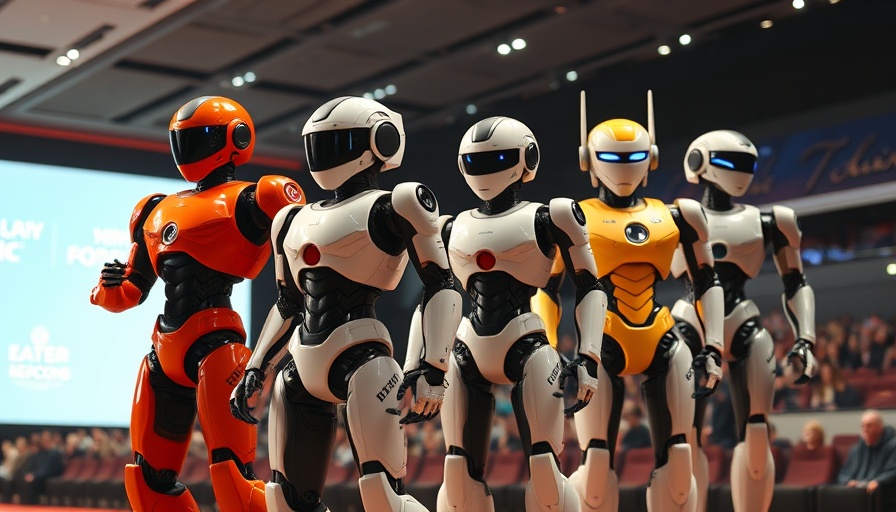
The Future Unveiled: China’s Humanoid Robots Redefining AI Capabilities
In recent years, China has emerged as a beacon of innovation in artificial intelligence and robotics, unveiling groundbreaking humanoid robots designed to blur the lines between technology and human interaction. A notable development is the K2 Bumblebee from Kepler Robotics, which effortlessly mimics human gait with straight knees. This advancement not only presents enhanced stability and energy efficiency but also challenges the traditional criticisms associated with humanoid robots, marking a pivotal evolution in their design.
In 'New China AI Robots SHOCK The World: Acting Human, Artificial Astronauts, Robotic Birth and More', the video explores groundbreaking advancements in robotic technology, prompting an in-depth analysis of the implications for society and beyond.
Breaking New Ground with Advanced Motor Skills
The K2 Bumblebee isn't just about aesthetic appeal; it boasts a sophisticated hybrid joint design that enables it to navigate complex environments. By utilizing advanced AI frameworks for multi-sensory processing—vision, language, and action—this robot can adapt in real-time, recover from disturbances, and showcase impressive manipulation abilities. Its potential applications in diverse settings such as warehouses and hospitals lay the groundwork for an era where humanoid robots become integral to daily operations.
Innovation Diversified: The Robotic Butler Revolution
While Kepler focuses on humanoid mobility, XSquare Robot pivots towards dextrous robotic manipulation. Their innovative Wall OSS, an open-source AI framework, strives to overcome the challenges of catastrophic forgetting and modal decoupling that plague current robotics. Notably, their Quanta X2 robot comes equipped with the ability to execute complex sequences of tasks, making it ideal for household chores, service work, or even industrial uses. The ambition to introduce these robots as everyday household assistants within just five years seems audacious yet feasible, given the current technological acceleration.
Controversial Implications of Robotic Reproduction
One of the most captivating—and contentious—proposals has emerged from Kaiwa Technology, which aims to produce a humanoid robot equipped with an artificial womb. This concept, envisioning a robot capable of gestating a fetus, pits advanced reproductive technologies against ethical dilemmas and societal norms. The duality of potential as a solution for infertility versus concerns over ‘robot surrogates’ invites crucial dialogues on the future of AI in human reproduction.
Domestic Robotics: A Taste of Everyday AI
Not all innovations exhibit the ostentation of humanoid design; practical applications are visibly infiltrating daily life. jA recent example is the ACAPE, a robot massage therapist in San Antonio, Texas, which utilizes advanced mechanics to deliver what users describe as human-like massages. While debates over its efficacy and the anxiety stemming from robotic interactions persist, it offers an accessible alternative to traditional massage therapy—albeit with its limitations.
Visionaries of the Future: Space and Beyond
Elon Musk’s ambitions parallel these advancements. His master plan embraces AI not merely as an aide but as a fundamental tool for redefining labor. Meanwhile, NASA envisions humanoid robots as future space travelers, with the potential for them to replace humans in hazardous environments. Projected timelines for sending robots to Mars reflect an escalating dependence on humanoid technology as foundational to interplanetary exploration.
AI and Robotics: Shaping Society's Future
The trajectory of humanoid robotics raises pertinent questions about societal adaptation and ethical considerations in automation. As advancements unfold, the index of AI adoption in jobs is accelerating; those adept at leveraging AI tools will find themselves in advantageous positions. As the landscape evolves rapidly, understanding these nuances will be imperative for navigating future job markets and societal dynamics.
Final Reflections on the AI Evolution
In a world where technology is evolving faster than societal norms can adapt, an educational resource emerges as essential for those looking to stay ahead. Programs such as Outskill’s AI mastermind workshop offer opportunities to harness these technologies, ensuring that both enthusiasts and professionals can maximize their potential in an AI-driven future. By equipping oneself with AI skills, one can engage more meaningfully with these advancements, from understanding robotics to redefining personal career trajectories.
As we witness remarkable feats in robotics and AI, it is essential for the tools of tomorrow to be accessible today. The rapid development raises questions about the pace at which we can adapt to these changes—and what role each individual will play as we transition into this exciting frontier.
 Add Row
Add Row  Add
Add 




Write A Comment